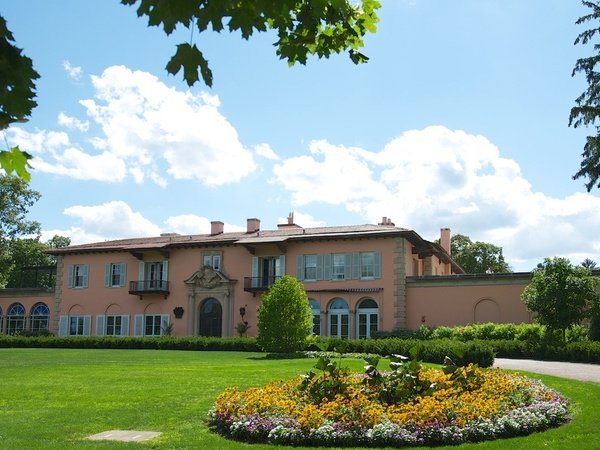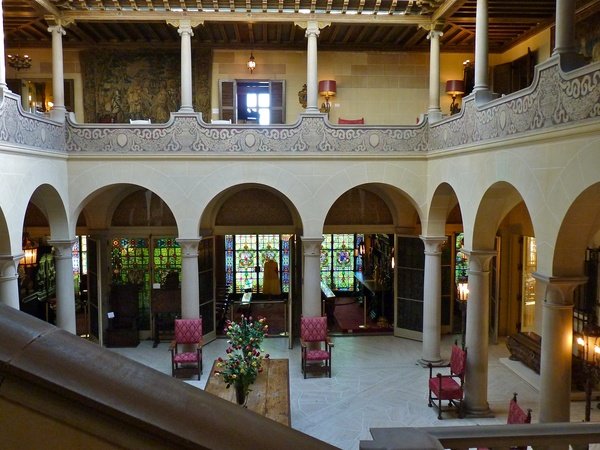Cuneo Mansion and Gardens
Built between 1914 and 1916, the Cuneo Mansion and Gardens is a beautifully preserved Italian Villa-style home. Originally built for Samuel Insull, the founder of Commonwealth Edison, the home was purchased in 1937 by John Cuneo, Sr. On display are the Cuneos’ European and American antiques, some hundreds of years old.
1350 North Milwaukee Avenue
Vernon Hills, IL 60061
847-362-3042
-
Italy in Chicago
Designed by Chicago architect Benjamin Marshall in the Italian Villa style, the Cuneo Mansion features an interior courtyard covered by a once-retractable skylight and surrounded by Ionic columns topped by an intricately carved frieze. Other features include a grand staircase, balustrade, and a second-floor colonnaded loggia with a painted wooden-panel ceiling.

-
All that Glitters Is Actually Gold
The Cuneo Mansion has 13 bathrooms—four in the back of the house for staff, and nine in the front of the house. Every bedroom for family and guests has its own private bath. And all are gilded—the walls, the sink pedestal, even the base of the commode.

-
Cuneo’s Antiques
John Cuneo, Sr. avidly collected American and European antiques. Highlights of the collection include a 16th-century German suit of armor, a 19th-century Italian pietre dure table, an early 20th-century American Steinway art-case piano, and two 19th-century Ormolu and Sevres style porcelain-inset gueridons.

-
Pass the Butter, Hopalong
The two tables in the formal dining room and breakfast room could be joined together for dinner parties of up to 64 people. Guests of the Cuneos included television star Hopalong Cassidy, Chicago Mayor Richard H. Daley, Samuel A. Cardinal Stritch, publisher William Randolph Hearst, and even future president Ronald Reagan.

-
You Baroque It…
The Cuneo collection focuses on Italian Baroque and Renaissance paintings, much of it religious in nature. Also included in the collection are cassones, or chests, dating from the 15th century, as well as Flemish, French, and English tapestries from the 16th century.

-
Businessmen of Words and Light
Built between 1914 and 1916 for Samuel Insull, founder of Commonwealth Edison, the mansion was purchased in 1937 by printing magnate John Cuneo, Sr. Cuneo’s business, the Cuneo Press, printed materials for the Roman Catholic Church, Sears Roebuck and Company, and publisher William Randolph Hearst.

-
Otis Elevator
Completed in 1916, the Cuneo Mansion incorporates the latest technological innovations of the era, including electric lights at a time when most homes nearby still used gas lighting. The mansion was also built with central heating and central plumbing, and boasts the oldest working elevator in Lake County.

-
Gilded Steinway
The ballroom, also called the music room, hosted many a festive event at the Cuneo Mansion. Music was provided by the 1904 Steinway art-case piano. Gilded and decorated with hand-painted motifs and portraits of famous composers throughout history, the piano was made for Julia Cuneo’s mother, a concert pianist.

-
Garden Retreat
A tranquil retreat from the modern world, the Cuneo gardens were designed by noted landscape architect Jens Jensen. John Cuneo, Sr. redesigned many of the garden ‘rooms’ to suit his more formal tastes. However, remnants of Jensen’s original design remain, including the cobblestone bridge, waterfall, man-made lakes, and council circle.

-
Religious Iconography
Designed by Chicago ecclesiastical painter John Mallin and fabricated by Tiffany Studios artist Arthur J. Michaudel, the windows in the Cuneo Mansion chapel depict various scenes from the life of Jesus Christ and other religious scenes. One panel depicts John Cuneo, Jr. and his younger sister, Consuela, with their guardian angel.


